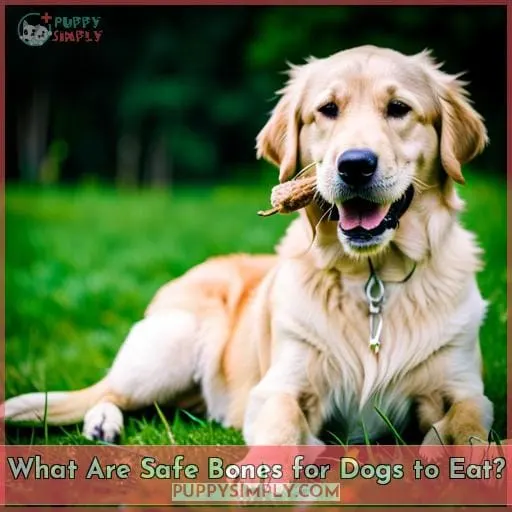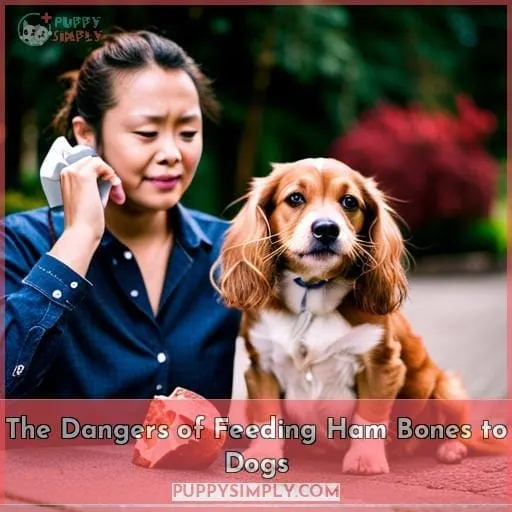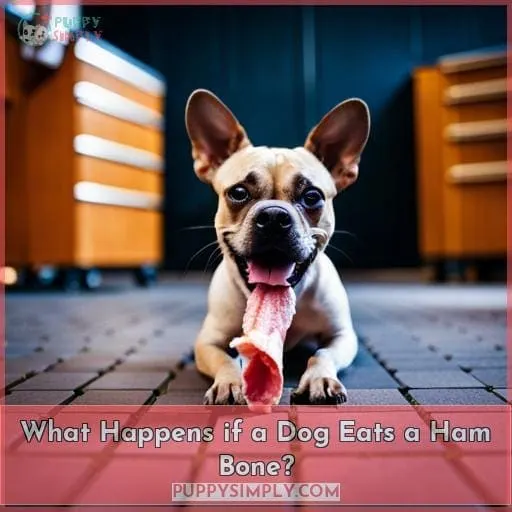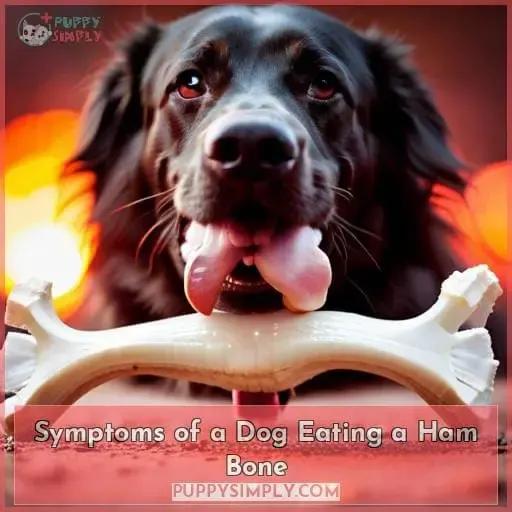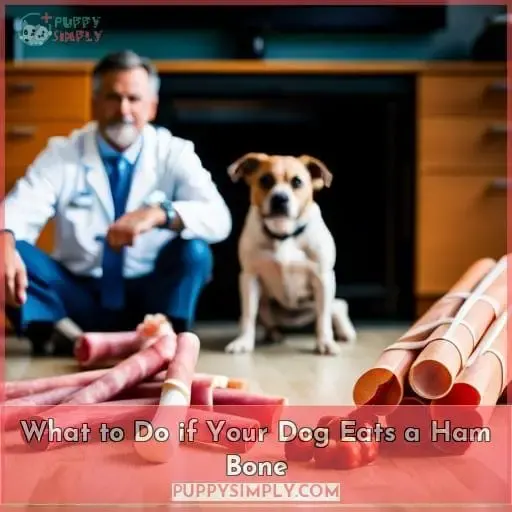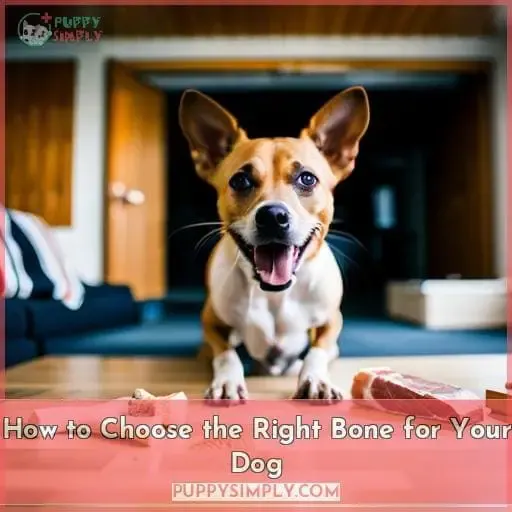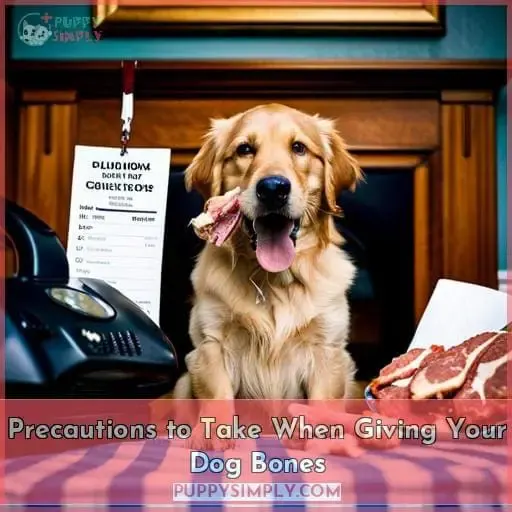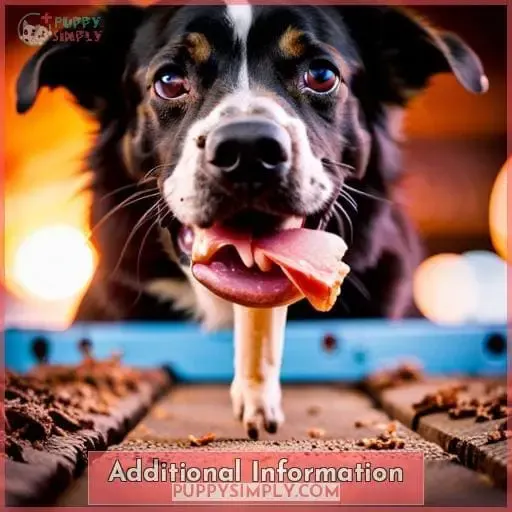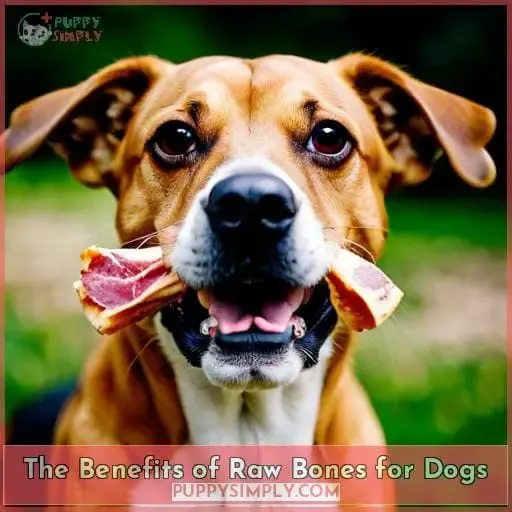This site is supported by our readers. We may earn a commission, at no cost to you, if you purchase through links.
You’re walking in the park with your pup, enjoying a sunny day. Suddenly, you spot something glinting in the grass – it’s a bone from someone’s ham dinner! You know that bones can be good for dogs but wonder if this particular type is safe.
Can dogs eat raw ham bones?
The answer to this question isn’t always straightforward and requires careful consideration. Ham bones are brittle and break down easily into sharp shards, which can cause serious damage to a dog’s digestive system or even choke them if they swallow large pieces of the bone whole.
What’s more, cooked ham bones can be even more hazardous than their raw counterparts as they may contain toxins that could lead to further health complications such as internal bleeding or inflammation of their intestinal lining.
It is important then to understand both what kinds of food are safe for our canine companions and how we should go about providing them with these treats safely.
Table Of Contents
- Key Takeaways
- What Are Safe Bones for Dogs to Eat?
- The Dangers of Feeding Ham Bones to Dogs
- What Happens if a Dog Eats a Ham Bone?
- Symptoms of a Dog Eating a Ham Bone
- What to Do if Your Dog Eats a Ham Bone
- Other Bones That Are Not Safe for Dogs
- How to Choose the Right Bone for Your Dog
- Precautions to Take When Giving Your Dog Bones
- Additional Information
- The Benefits of Raw Bones for Dogs
- Frequently Asked Questions (FAQs)
- Conclusion
Key Takeaways
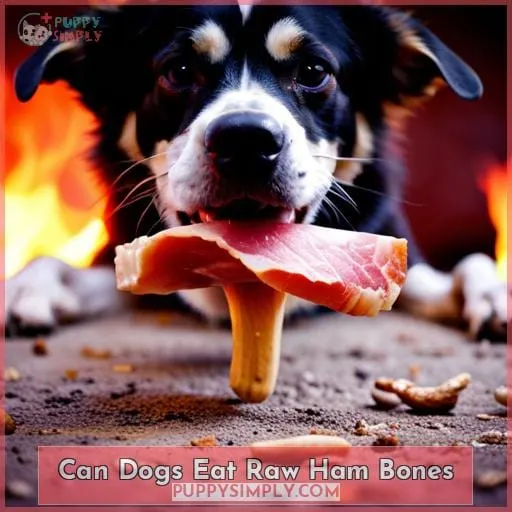
- Raw ham bones are hazardous for dogs and can cause serious digestive damage or choking.
- Cooked ham bones are even more dangerous as they may contain toxins that can lead to health complications.
- Rawhide chews or long-lasting dog chews are the best option for satisfying a dog’s chewing habits without risking health complications.
- Consulting with a veterinarian before offering bones to dogs and supervising their chewing activities is crucial for their safety and enjoyment.
What Are Safe Bones for Dogs to Eat?
It’s essential to understand which types of bones are safe for your canine companion and those that should be avoided. Generally, rawhide chews or long-lasting dog chews, such as deer antlers, are the best option for dogs when looking to satisfy their natural chewing habits without putting them at risk of health complications.
For dental hygiene, some softer bones like beef marrowbones can help scrape away tartar build-up from a dog’s teeth while providing nutritional benefits with its healthy fats and minerals. Butternut squash is also an excellent source of vitamins and fiber that will aid in digestion, making it a great alternative if you want to avoid giving your pup any type of bone chew altogether.
With proper supervision during meal times, appropriately sized bones (not too big nor small) can provide less injury risk than other options like cooked ham bone fragments, which could potentially cause problems in various parts of the digestive tract due to sharp edges or splintering shards upon ingestion by pups!
The Dangers of Feeding Ham Bones to Dogs
Feeding your pup ham bones can be hazardous to their health, with potentially dangerous consequences such as internal damage or even choking. Cooked ham bones are even more hazardous than raw ones, so it’s important to think twice before offering your dog this type of bone.
The risks include splintered bone shards which can cause cuts and scrapes in the dog’s mouth from its sharp incisors. Gastrointestinal issues can also occur due to small pieces becoming lodged in the gut.
Bones should fit well for chewing; otherwise, they could become stuck and cause obstruction problems or worse if ingested whole.
Wild canine teeth are designed for crunching through raw bones, but not all dogs have strong enough teeth nor the correct habits when it comes to chewing on them safely. This can likely lead to dental care issues too! To avoid these potential risks of your dog eating a ham bone, consult a veterinarian beforehand about safe practices.
Consider other options like providing soft food instead for digestion purposes while still getting some nutritional benefits from natural sources without risking harm.
What Happens if a Dog Eats a Ham Bone?
If your pup chews on a ham bone, they may experience harmful side effects and even life-threatening complications. Feeding safety is essential when it comes to these types of bones as the small pieces can easily lodge in their throat or cause digestive issues due to sharp fragments.
Pieces of bone that are too large for them could get stuck in the intestines, causing major problems if not removed quickly by a vet.
It’s always best to consult with your veterinarian before feeding anything other than kibble or treats approved specifically for dogs’ teeth and digestion. Raw bones can provide beneficial nutritional elements, but there has to be a good reason why you’re giving them one.
Make sure it’s an appropriate type of bone for their size! If you do decide raw bones are right for your dog, ensure they’re large enough so that only small pieces will come off when being chewed.
Supervision is key here. If you notice anything unusual, stop immediately and contact a veterinarian who can advise further on how best to proceed from there!
Symptoms of a Dog Eating a Ham Bone
If your pup has gotten into a ham bone, watch out for signs like vomiting, blood in the stool, loss of appetite, and struggling to poop. Ham bones can be particularly hazardous for dogs as they are brittle and can break down into thousands of sharp shards that could cause choking risk or internal damage.
This is especially true when it comes to cooked ham bones, which become even more dangerous than raw ones.
If you suspect your dog has eaten any type of bone fragment from a ham bone, then take them to the vet immediately for advice on how best to proceed. This includes monitoring their dental health due to potential splinters that may have been swallowed by mistake.
Feeding soft foods such as bread or pumpkin will help reduce the risks associated with eating a ham bone, but ensure you always consult with your veterinarian before adding new food types to their diet.
What to Do if Your Dog Eats a Ham Bone
If your dog has eaten a ham bone, the immediate steps you should take are to monitor your pet’s behavior closely for any worrisome symptoms. Raw bones can cause choking, internal damage, or blockages that could be fatal if not treated promptly.
Be aware of signs such as vomiting and diarrhea, lethargy, or decreased appetite, which may indicate trouble in their digestive system and require medical attention.
Immediate Steps
Take swift action if Fido gets into a ham bone – it’s not worth the risk of causing serious damage to their internal system! Feeding options, bone types, and chewing habits should all be assessed before giving your pup any type of bones.
Good news is there are nutritional benefits from raw bones for dogs, just like wild canine’s bones. However, you must select an appropriate size for your dog based on their teeth and size. Be sure to supervise while they chew, and consider consulting with a veterinarian about safe use in order to keep vet bills low.
If ingested, immediately contact your vet or animal emergency clinic. Bread and pumpkin can help reduce symptoms but may not prevent intestinal perforation or obstruction due to blockage of the digestive tract by larger chunks of bone fragments.
Troublesome Symptoms
Be aware of the troublesome symptoms that can occur if your canine companion has consumed a ham bone, such as vomiting, blood in the stool, difficulty pooping, and decreased appetite. Placing restrictions on dietary modifications is essential to help prevent choking hazards or digestive challenges.
Veterinary advice should be sought for any adverse reactions as organ damage could result from ingestion of raw bones or bone fragments, which may harm a dog’s teeth. Care should be taken when giving dogs bones to ensure their safety. Consulting with an expert before adding new foods is recommended for optimal health outcomes.
Other Bones That Are Not Safe for Dogs
It’s important to understand that certain bones can be dangerous for your canine companion. Feeding habits, such as giving cooked or raw bones, need careful consideration and vet advice before introducing them into your dog’s diet.
Dogs’ teeth are designed to crunch through the marrow of wild canine’s bones, but splintered bone’s sharp edges can lead to injury in the mouth and digestive tract. A blackish-red tar from cooked bones is more hazardous than natural calcium found in uncooked varieties since it’s a brittle type of bone that can break down easily into tiny fragments.
These fragments could cause blockages or punctures along their intestinal lining.
Bones should always be large enough so they won’t get stuck while chewing on them and supervised at all times for safety reasons.
How to Choose the Right Bone for Your Dog
When selecting a bone for your pup, it’s important to choose one that is large enough and sturdy enough to withstand their chewing. Chew-proofing the bone ensures dental health benefits as well as unlocking nutritional benefits.
Wild canine bones are excellent choices because they are designed for dog teeth without any added hormones or other additives. Bones should be larger than the size of your dog’s mouth so they won’t accidentally swallow them whole but small enough that they can handle them comfortably when chewing.
Consult with a veterinarian about safe sizes and types of bones before giving one to your pet, since some may be too hard or sharp on their teeth if not chewed properly.
Additionally, keep an eye out on how much time you let dogs chew these treats. Long periods can cause wear down tooth enamel over time, even if the chosen bone is fit correctly for their mouths!
Precautions to Take When Giving Your Dog Bones
Taking precautions when offering your pup bones is essential to ensure their safety. Selecting the right bone for your furry friend is key – raw bones are better than cooked ones, but there’s still a risk depending on the type of meat and bone structure.
Bones should be large enough for them to chew without too much effort, yet small enough that they don’t choke or break into splintered pieces with sharp edges.
Supervising them while they eat and ensuring regular vet check-ups will help minimize any potential harm from consuming a wrong choice of bone. A general rule of thumb: if it won’t fit in their mouth easily, you probably shouldn’t give it to them! Chewing helps dogs maintain strong teeth while also aiding digestion; however, making sure they’re not eating anything hazardous requires extra attention from owners.
Consulting with an animal nutritionist or veterinarian before introducing new food items can make all the difference in keeping our canine companions safe while providing necessary dental health benefits at home!
Additional Information
You may have heard that raw ham bones can be dangerous for dogs, but it is important to understand the risks associated with feeding them these types of bones. AZ Animals and MasterClass share information on why you should avoid giving your dog a raw ham bone in order to keep them safe from potential health hazards.
In this discussion, we will explore the reasons behind avoiding feeding dogs raw ham bones so that you can make an informed decision about their dietary needs.
AZ Animals
Discover the answer to your canine questions with AZ Animals’ helpful articles and instructional videos from animal trainer Brandon McMillan. Get informed about raw nutrition, bone safety, dental health, and vet advice for your pup’s diet.
Here are some tips to keep in mind:
- Dogs’ teeth are designed for crunching on wild canines’ bones – this is an important part of their dental health.
- Consult a veterinarian before adding any human food to their diet.
- Bones should be large enough that they won’t choke or cause intestinal damage when chewed.
Keep these things in mind as you provide natural nutrition for your four-legged family member! With careful monitoring and a few simple precautions, you can ensure that the bones you give them will promote optimal health without putting them at risk of harm.
MasterClass
Unlock the secrets to building trust and control with your beloved canine companion by taking Brandon McMillan’s MasterClass. You can learn how to train your pup using positive reinforcement, nutrition advice, dental hygiene guidelines, and exercise routines on this comprehensive platform.
Developed from his experience as an animal trainer, McMillan shares tips for keeping your dog’s teeth strong through wolf-like chewing habits that naturally wear down a dog’s teeth. He also advises avoiding high-fat content foods like ham bones, which could break off into sharp bone pieces.
The Benefits of Raw Bones for Dogs
Giving your furry friend a raw bone can provide them with countless benefits, from improved nutrition and dental health to lower vet bills. Feeding techniques must be carefully tailored to the dog’s size, breed, and chewing habits in order for it to be safe.
Raw bones offer an excellent source of calcium that helps build strong teeth, as well as providing natural minerals such as phosphorus, which is essential for healthy growth and development.
Chewing on these types of bones also promotes good dental hygiene by helping remove plaque buildup on a dog’s teeth while also massaging their gums at the same time. Even though there are risks associated with giving dogs raw meaty bones, if done correctly under supervision, it can help prevent digestive system issues.
Eating them will help keep large chunks from forming an obstruction or causing internal damage due to sharp splinters being created when chewed up small enough pieces swallowed by accident.
Frequently Asked Questions (FAQs)
Are cooked ham bones more hazardous than raw ones?
Yes, cooked ham bones are more hazardous than raw ones. They can easily break into dangerous shards that may cause blocked intestines, choking, internal damage, and mouth damage in dogs. It is always advisable to consult your veterinarian before giving any new food to your dog.
How can I tell if my dog has eaten a ham bone?
If your dog has eaten a ham bone, watch for signs of vomiting, blood in the stool, loss of appetite, difficulty defecating, and fatigue. Monitor your dog closely and consult with a veterinarian if you have any concerns.
How often should I give my dog bones?
It’s best to give bones sparingly, as too many can lead to digestive issues. Raw bones are preferable over cooked, and they should be large enough for your dog to chew safely. The type of bone also matters – avoid ham or other soft varieties that could break down into sharp shards.
What are the benefits of giving my dog raw bones?
If you want to keep your pup healthy and happy, consider giving them raw bones. These bones offer numerous benefits, including improved dental hygiene, stronger jaw muscles, more nutrients from bone marrow, and mental stimulation.
However, it’s important to supervise your dog while they chew for safety reasons.
Is it safe to give my dog bones from the grocery store?
It is not recommended to give your dog bones from the grocery store as they can be dangerous and cause blockages. It is best to consult a vet before feeding your dog any type of bone. While raw bones may offer nutritional benefits, they still carry risks.
Conclusion
It’s important to remember that bones can be hazardous for dogs, and that ham bones in particular are not safe. Supervision and careful selection of bones are key to helping your dog stay healthy and safe.
With the right bones, you can unlock nutritional and dental benefits for your pup and avoid costly vet bills.
Imagine your pup happily chewing away on a large, safe bone, exercising their jaw and teeth, and getting all the delicious nutrients their body needs. With proper guidance and a little bit of caution, your pup can enjoy the benefits of bones for years to come.

